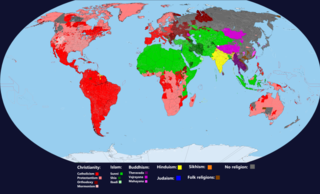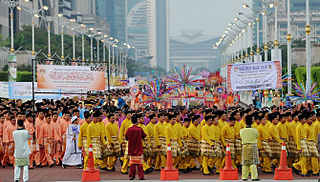
Tatarstan, officially the Republic of Tatarstan, sometimes also called Tataria, is a republic of Russia located in Eastern Europe. It is a part of the Volga Federal District; and its capital and largest city is Kazan, an important cultural centre in Russia. The region's main source of wealth is oil with a strong petrochemical industry.

A religious denomination is a subgroup within a religion that operates under a common name and tradition, among other activities. The term refers to the various Christian denominations. It is also used to describe the five major branches of Judaism. Within Islam, it can refer to the branches or sects, as well as their various subdivisions, such as sub-sects, schools of jurisprudence, schools of theology and religious movements.

Isma'ilism is a branch or sect of Shia Islam. The Isma'ili get their name from their acceptance of Imam Isma'il ibn Jafar as the appointed spiritual successor (imām) to Ja'far al-Sadiq, wherein they differ from the Twelver Shia, who accept Musa al-Kazim, the younger brother of Isma'il, as the true Imām.
In Shia Islam, the Imamah is a doctrine which asserts that certain individuals from the lineage of the Islamic prophet Muhammad are to be accepted as leaders and guides of the ummah after the death of Muhammad. Imamah further says that Imams possess divine knowledge and authority (Ismah) as well as being part of the Ahl al-Bayt, the family of Muhammad. These Imams have the role of providing commentary and interpretation of the Quran as well as guidance.

The Khanate of Kazan was a medieval Tatar Turkic state that occupied the territory of the former Volga Bulgaria between 1438 and 1552. The khanate covered contemporary Tatarstan, Mari El, Chuvashia, Mordovia, and parts of Udmurtia and Bashkortostan; its capital was the city of Kazan. It was one of the successor states of the Golden Horde (Mongol state), and it came to an end when it was conquered by the Tsardom of Russia.

Islam is a major religious minority in the Russian Federation, which has the largest Muslim population in Europe excluding Turkey. According to the US Department of State in 2017, Muslims in Russia numbered 14 million or roughly 10% of the total population. One of the Grand Muftis of Russia, sheikh Rawil Gaynetdin, estimated the Muslim population of Russia at 25 million in 2018.

Mawlid is an annual festival commemorating the birthday of Islamic prophet Muhammad on the traditional date of 12 Rabi' al-Awwal, the third month of the Islamic calendar. A day central to the traditions of Sunni Islam, the Mawlid is also celebrated by Shia Muslims.

Religion in the Union of Soviet Socialist Republics (USSR) was dominated by the fact that it became the first state to have as one objective of its official ideology the elimination of existing religion, and the prevention of future implanting of religious belief, with the goal of establishing state atheism (gosateizm). However, the main religions of pre-revolutionary Russia persisted throughout the entire Soviet period and religion was never officially outlawed. Christians belonged to various denominations: Orthodox, Catholic, Baptist and various other Protestant denominations. The majority of the Muslims in the Soviet Union were Sunni, with the notable exception of Azerbaijan, which was majority Shia. Judaism also had many followers. Other religions, practiced by a small number of believers, included Buddhism and Shamanism.

The territory of Tatarstan, a republic of the Russian Federation, was inhabited by different groups during the prehistoric period. The state of Volga Bulgaria grew during the Middle Ages and for a time was subject to the Khazars. The Volga Bulgars became Muslim and incorporated various Turkic peoples to form the modern Volga Tatar ethnic group.

Islamic schools and branches have different understandings of Islam. There are many different sects or denominations, schools of Islamic jurisprudence, and schools of Islamic theology, or ʿaqīdah (creed). Within Islamic groups themselves there may be differences, such as different orders (tariqa) within Sufism, and within Sunnī Islam different schools of theology and jurisprudence. Groups in Islam may be numerous, or relatively small in size.

The Volga Tatars or simply Tatars are a Kipchak-Bulgar Turkic ethnic group native to the Volga-Ural region of western Russia. They are subdivided into various subgroups. Volga Tatars are the second-largest ethnic group in Russia after ethnic Russians. Most of them live in the republics of Tatarstan and Bashkortostan. Their native language is Tatar, a language of the Turkic language family. The predominant religion is Sunni Islam, followed by Orthodox Christianity.
The Catacomb Church as a collective name labels those representatives of the Russian Orthodox clergy, laity, communities, monasteries, brotherhoods, etc., who for various reasons, moved to an illegal position from the 1920s onwards. In a narrow sense, the term "catacomb church" means not just illegal communities, but communities that rejected subordination to the acting patriarchal locum tenens Metropolitan Sergius (Stragorodsky) after 1927, and that adopted anti-Soviet positions. During the Cold War of 1947-1991 the Russian Orthodox Church Outside of Russia popularized the term in the latter sense, first within the Russian diaspora, and then in the USSR. The expression "True Orthodox church" is synonymous with this latter, narrower sense of "catacomb church".

Religious exclusivism, or religious exclusivity, is the doctrine or belief that only one particular religion or belief system is true. This is in contrast to religious pluralism.

The siege of Kazan in 1552 was the final battle of the Russo-Kazan Wars and led to the fall of the Khanate of Kazan. Conflict continued after the fall of Kazan, however, as rebel governments formed in Çalım and Mişätamaq, and a new khan was invited from the Nogais. This guerrilla war lingered until 1556.
According to Article 9 of the Lebanese Constitution, all religions and creeds are to be protected and the exercise of freedom of religion is to be guaranteed providing that the public order is not disturbed. The Constitution declares equality of rights and duties for all citizens without discrimination or preference. Nevertheless, power is distributed among different religious and sectarian groups. The position of president is reserved for a Maronite Christian; the role of Presidency of Parliament for a Shiite Muslim; and the role of Prime Minister for a Sunni Muslim. The government has generally respected these rights; however, the National Pact agreement in 1943 restricted the constitutional provision for apportioning political offices according to religious affiliation. There have been periodic reports of tension between religious groups, attributable to competition for political power, and citizens continue to struggle with the legacy of the civil war that was fought along sectarian lines. Despite sectarian tensions caused by the competition for political power, the Lebanese continue to coexist.

Kazan Theological Seminary is the principal Russian Orthodox seminary in the Diocese of Kazan and Tatarstan.

Islam in Tatarstan existed prior to the tenth century, but it began major growth in 922, when Bulgar ruler Almış converted to Islam. This was followed by an increase in missionary activity in Volga Bulgaria. Islam remained the dominant religion through the Mongol invasion and subsequent Khanate of Kazan. In 1552, the region was finally conquered by Russia, bringing the Volga Tatars and Bashkirs on the Middle Volga into the tsardom. Under Russian rule, Islam was suppressed for many years, first during the Tsardom and Empire and later during the Soviet era. Today, Islam is a major faith in Tatarstan, adhered to by 47.8–55 percent of the estimated 3.8 million population, making it one of the two dominant religions in the region, the other being Orthodox Christianity.
Ali Illahism is a syncretic religion which has been practiced in parts of the Luristan region in Iran which combines elements of Shia Islam with older religions. It centers on the belief that there have been successive incarnations of the Deity throughout history, and Ali Illahis reserve particular reverence for Ali, the son-in-law of the Islamic prophet Muhammad, who is considered one such incarnation. Various rites have been attributed as Ali Illahian, similarly to the Yezidis, Ansaris, and all sects whose doctrine is unknown to the surrounding Muslim and Christian population. Observers have described it as an agglomeration of the customs and rites of several earlier religions, including Zoroastrianism, historically because travelogues were "evident that there is no definite code which can be described as Ali Illahism."

Musa ibn Ja'far al-Kazim was a descendant of the Islamic prophet Muhammad and the seventh imam in Twelver Shia Islam. Musa is often known by the title al-Kazim, apparently a reference to his patience and gentle disposition. He was born in 745 CE in Medina to Ja'far al-Sadiq, the sixth Shia imam, who died in 765 without publicly designating a successor to save his heir from the wrath of the Abbasid caliphs. The subsequent crisis of succession was eventually resolved in favor of al-Kazim, with a dissenting group, now known as the Isma'ilis, separating from the mainstream Shia.

The Ahmadiyya branch in Islam has relationships with a number of other religions. Ahmadiyya consider themselves to be Muslim, but are not regarded as Muslim by mainstream Islam. Mainstream Muslim branches refer to the Ahmadiyya branch by the religious slur Qadiani, and to their beliefs as Qadianism a name based on Qadian, the small town in India's Punjab region where the founder of Ahmadiyya, Mirza Ghulam Ahmad was born.















